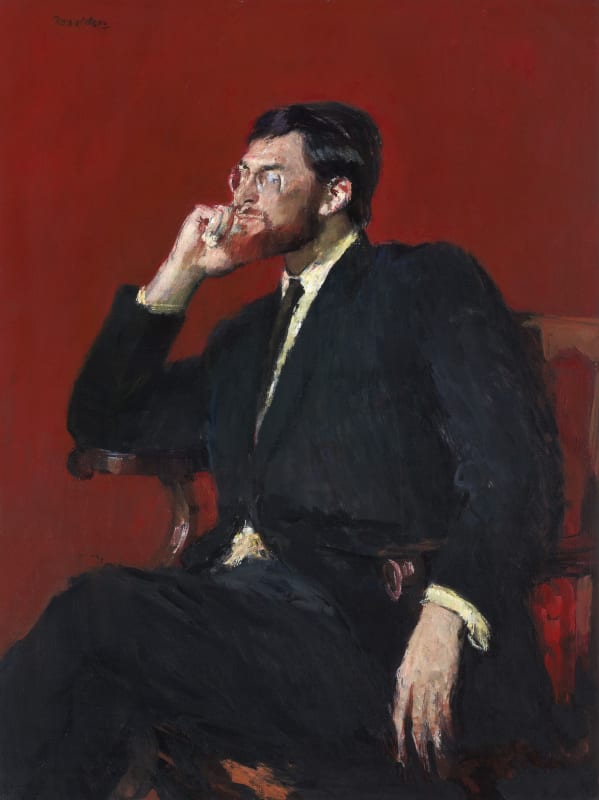Elected ARSA: 21 March 1951
Elected RSA: 14 February 1962
Former Head of Painting, Glasgow School of Art. Her Majesty's Painter and Limner in Scotland. Born 29 June 1916 in Chryston, Lanarkshire. Died 22 August 1996. David Donaldson was one of the most important and influential figures in Post War Scotland.
Born in humble circumstances his career took him from the back streets of Coatbridge to a hugely successful life as a portrait painter and also earned a well deserved reputation as a painter of still life. He became the recipient of a multitude of Honours, including Honorary degrees from both Strathclyde and Glasgow University.
He was elected to the Royal Scottish Academy in 1962 and in 1977 was appointed the Queen's Limner in Scotland. At the time of his death he was Honorary Vice-President of the Glasgow School of Art, where he had been Head of the Painting Department from 1967 to 1981.
His work is represented in distinguished collections world wide and he maintained studios in France and London as well as Glasgow. A complex character, very often pompous himself, he abhorred it in others, but possessing an outrageous sense of humour - he was ever ready to laugh at himself. His humour was very much in the Glasgow tradition and he was much sought after as a raconteur.
His years spent as a student were very much in the academic tradition common to all Scottish Art Schools in the thirties, and, as his early work clearly shows, he was an exceptionally talented student. The influences of Rembrandt and Velasquez in particular remained with him all his life.
Curiously, in later life he showed no interest in the wide-ranging formal discoveries of modern art. Cubism and abstraction meant little or nothing to him and he totally ignored contemporary trends or fashions in Art He was essentially only really concerned with his own art and spent his life developing his own singular vocabulary.
Donaldson was a brilliant teacher. He believed that a young painter should learn from a good older painter and what he had to say was direct and to the point - he also all his life maintained that “painting about it” rather than “talking about it” was the correct equation. He was fond of his students and often referred to himself as their “guide, philosopher and friend”. He had not time for a drunken foul-mouthed Scottish Artist image - he liked to portray himself as an elegant cultured painter and tried to instil in many young artists, that an interest in literature, music etc. were integral parts in developing one’s career as a painter.
His relationship with his staff was one of total vacillation - one day sweetness and light - the next raging and raving - those mood swings were very much to do with the business of being a painter and often indicated personal anxieties. For the most part however his staff respected him enormously and held him in great regard.
David's idea of an Art School was one where rigorous study in the classical tradition would be combined with a civilised and bohemian life style - free from strictures of a puritanical outside world. He would make a monthly round of the studios with his staff in tow, inspecting the work of the students, occasionally attempting to put a stop to anything which smacked of the “avante-garde”.
He despised the Art School's adoption of a quasi-university structure and its acceptance of faded degrees for painting! He looked upon Academic meetings as intrusions into the proper work of an artist/teacher and would stuff unopened agendas into the nearest bottom drawer. How he would have loathed the growth of the bureaucratic systems now in place in all Art Schools.
In all of his work David's approach to the subject whether still life, portrait or landscape was one of direct confrontation - he never worked from preparatory drawings or kept sketches, he favoured the poetic and instinctive approach combining a strong imaginative vision and the sensual quality of the paint itself.
His love of bravura and virtuosic elements in his later landscapes and still lifes resulted in what many regard as his finest works. His large body of portraits remain unique in 20th century Scottish painting. The special skill needed to combine painterly qualities with a successful likeness made him an heir to the mantle of previous Scottish portrait painters such as Raeburn.
His more informal portraits of his family and friends reveal a marvellous spontaneity and are imbued with the intrinsic sensitivity contained in all his work. His many self-portraits are amongst his greatest works - often witty, often especially when concerned with the passing of time, wistful and moving.
David's retrospective exhibition at the Talbot Rice Gallery in late June 1996, was combined with his 80th and what, sadly, turned out to be his last birthday. The splendid exhibition coincided with the publication of a book about him by W. Gordon Smith. At the opening - packed with friends and admirers - David offered a few words of wisdom to those who were willing to listen.
By that time, it was obvious that he was a sick man and the moment was made all the more poignant by the deaths of both David and Gordon Smith, whose book is a perfect testament of David’s life and work. Although remembered mostly for his works in oils - David was a consummate water colourist especially in the many paintings he made of the French countryside.
He was elected an RSW on 18 November 19938. David Donaldson was twice married. From his first marriage in 1942 to Kathleen Maxwell he leaves one son David. His widow Marysia whom he married in 1948 is the mother of his two daughters Sally and Caroline.
RSA Obituary by James D. Robertson RSA. Transcribed from 1996 RSA Annual Report

